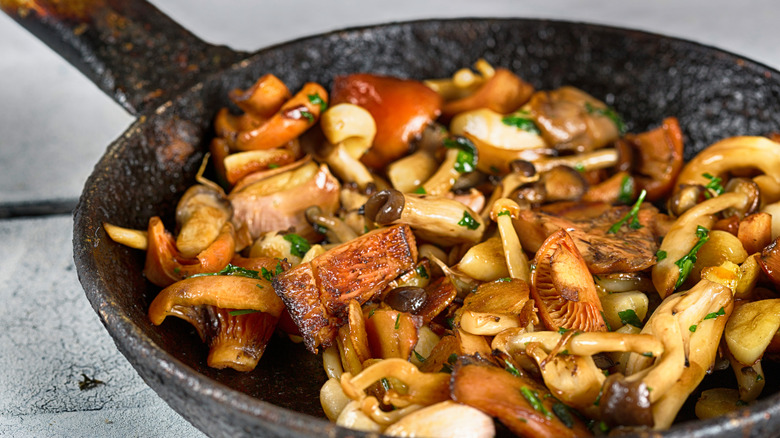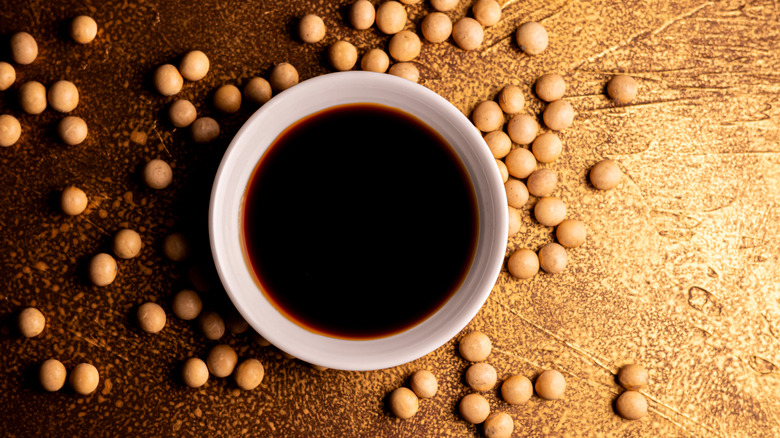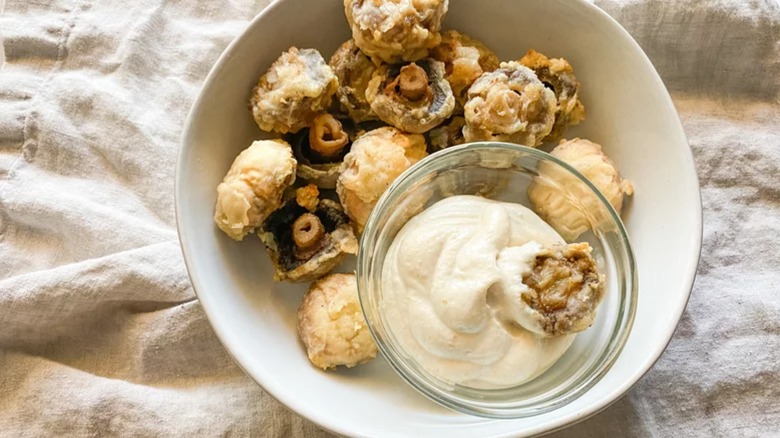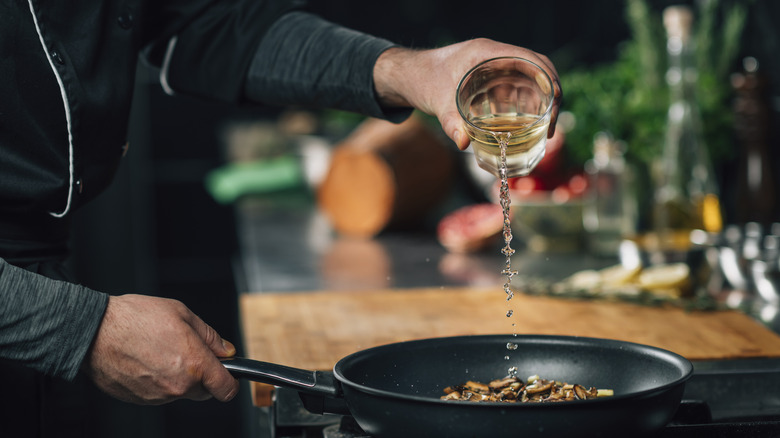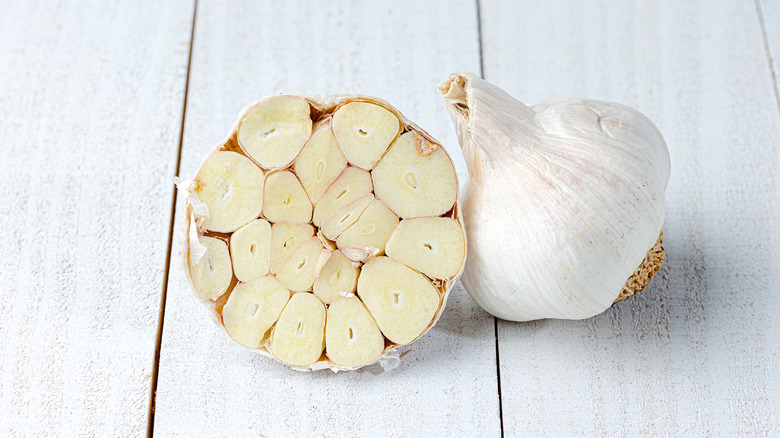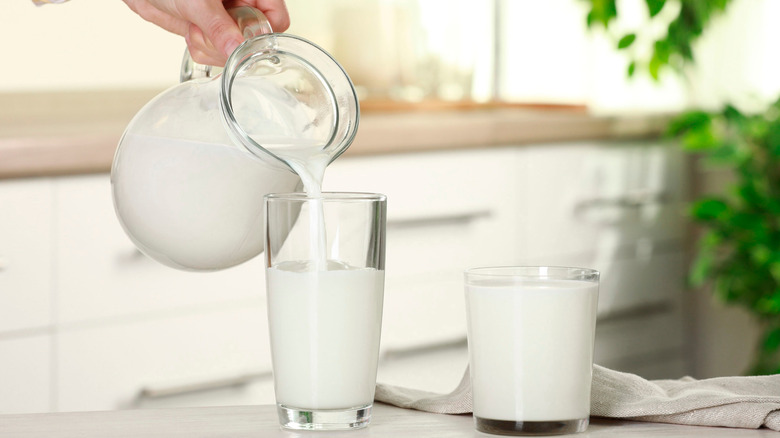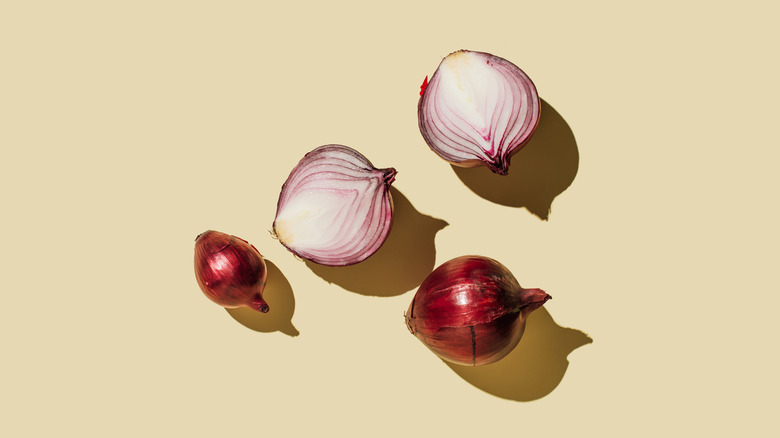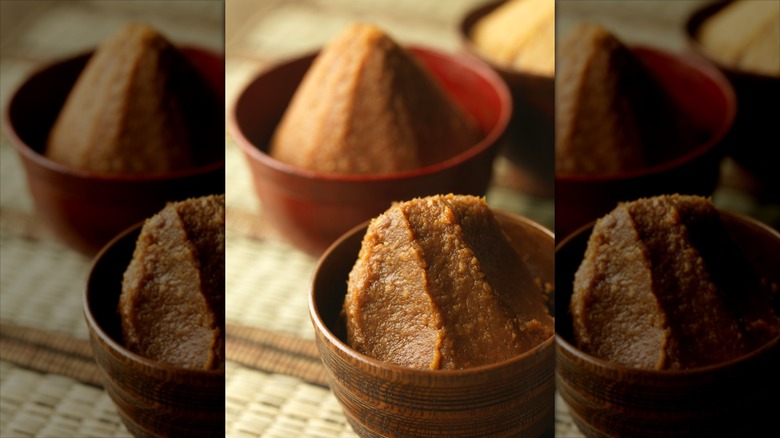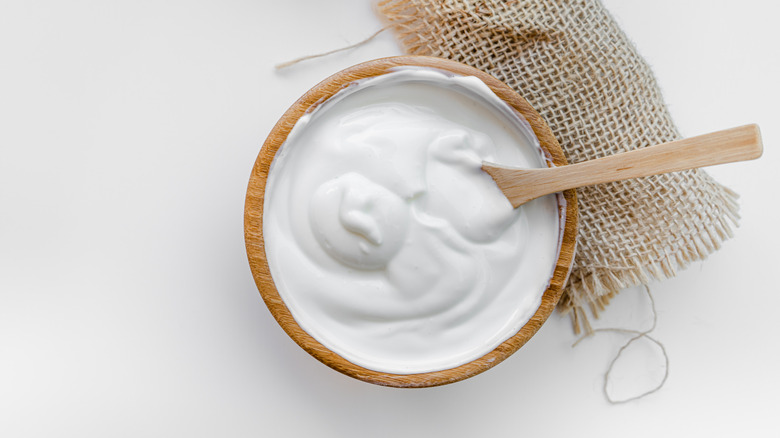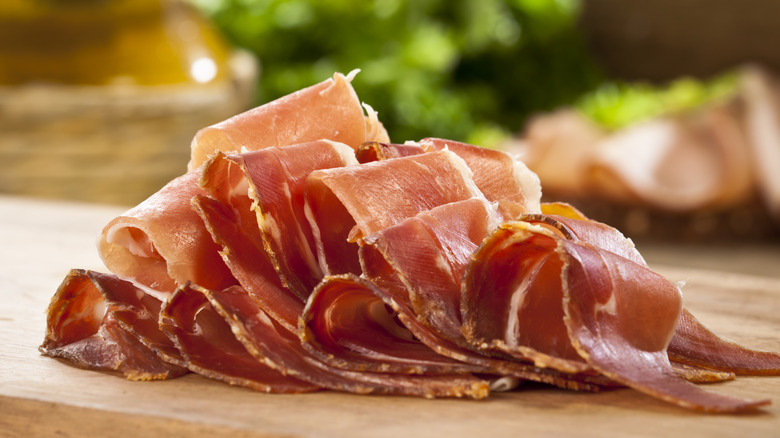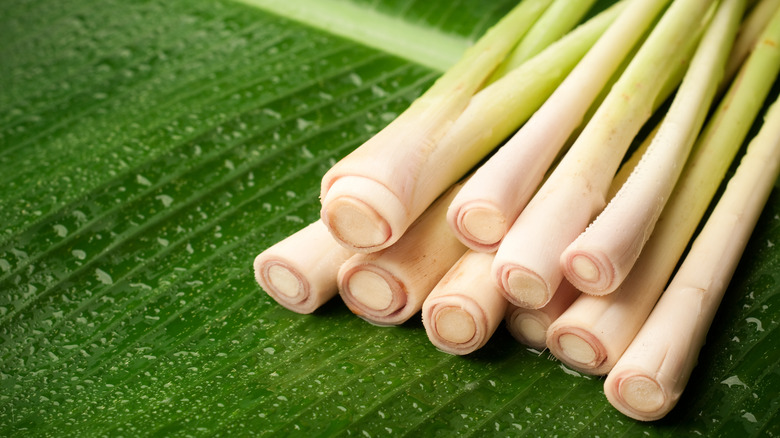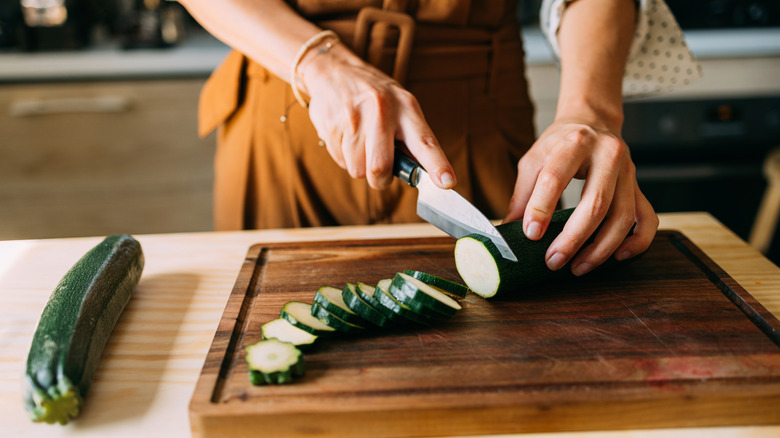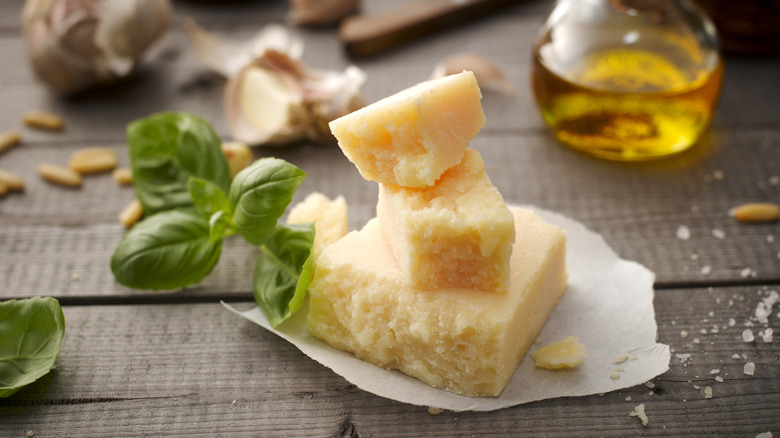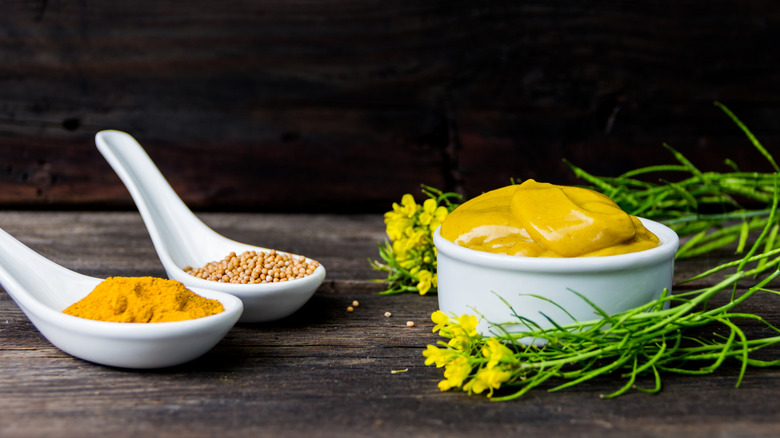15 Ingredients That Will Take Sauteed Mushrooms To The Next Level
If you're looking for a delicious and healthy side dish, you could do a lot worse than sautéed mushrooms. They feature an earthy, umami flavor that pairs well with just about everything, whether you're cooking steak, polenta, or shrimp scampi. If you're cooking a fully vegetarian meal, they also have a meaty texture that will satisfy even non-vegetarians. In addition to their flavor and textural benefits, mushrooms boast a hefty dose of vitamins, including selenium, potassium, phosphorus, and B vitamins. They are also full of ergothioneine, an antioxidant that helps prevent cellular damage. A meta-analysis of 17 cancer studies between 1966 and 2020 found a connection between eating mushrooms and a lower risk of cancer, with the most significant findings pointing to a lowered risk of breast cancer. Given these health benefits, it's no wonder mushrooms have been used in traditional medicine for thousands of years.
There are many different types of mushrooms you can use for sautéing, but the ubiquitous and affordable cremini or white button mushrooms will do just fine, as long as you add a little flavor to them. Keep reading to discover some of the best ingredients to make mushrooms the star of the meal.
Soy sauce
Mushrooms have a naturally umami-rich flavor. Despite being one of the five basic tastes, umami is often harder to describe than sweetness, saltiness, bitterness, or sourness. Depending on who you ask, it is a meaty, savory, earthy, even brothy flavor. This illusive taste is derived from the amino acid called glutamate that is found in high concentrations in foods like Parmesan cheese, anchovies, and seaweed. It is a standout flavor in Asian cooking, especially Japanese and Chinese cuisine.
One of the most highly-concentrated sources of umami flavor is soy sauce, which is made with fermented soybeans and has been used as a seasoning in Asia since Ancient times. Mushrooms bring their own umami flavor, but it can be very subtle, especially with varieties like cremini and button mushrooms. To dial up that pleasurably meaty, savory taste, soy sauce is the perfect option. Our recipe for buttery mushroom polenta capitalizes on this deliciously complementary ingredient match-up, calling for just one tablespoon of soy sauce for 21 ounces of mushrooms. The results are so delicious that you could skip the polenta altogether and serve the mushrooms as a standalone side dish.
Breading
If you've ever been to a Logan's Roadhouse location, you might have noticed that the fried 'shrooms are extremely popular. If you ordered some for yourself, you know why. Crunchy, salty, and just the right amount of chewy, they are served with horseradish sauce for even more flavor and are, without question, one of the best side dishes that the steakhouse chain has to offer. But you don't have to take our word for it. You can make it in your own home. Dietician and Mashed recipe developer Kristen Carli has created a copycat version of Logan's Roadhouse fried mushrooms, and it is every bit as delicious as the kind you can order from the restaurant.
Making them is surprisingly straightforward. In fact, you only need to set aside 15 minutes — 10 for preparing the ingredients and five for cooking. All you have to do is coat the mushrooms in a seasoned flour mixture, dip them in buttermilk, and dredge them in the flour mixture again. Fry them in a skillet with canola oil and serve them with a flavor-packed dip like creamy horseradish sauce or easy roasted garlic aioli.
White wine
White wine is one of those ingredients that can completely transform a wide variety of savory dishes. It may not be as ubiquitous an ingredient as soy sauce or vinegar, but there is a solid argument for keeping some on hand just for cooking. It plays a similar role as lemon juice, brightening the flavor of a dish with its acidity. Depending on the type of white wine you're using, it may add a crisp and sharp note of acidity or a softer, sweeter one. In general, white wine is easier to cook with than red wine, which provides a richer, more distinct flavor.
Our recipe for sautéed mushrooms uses white wine to bring out the rich umami flavor of the main ingredient. It's important to note, especially if you aren't using a recipe, that you only need a small amount of wine to make a difference. You don't want to end up with boozy mushrooms. All you need is one or two tablespoons per eight to 12-ounce package of mushrooms. Make sure to add the wine early enough to allow the alcohol to burn off slightly, but keep in mind that it won't burn off entirely.
Garlic
It's no surprise that garlic makes a great addition to sautéed mushrooms because it makes a great addition to almost every savory dish. Sharp and a little spicy, garlic is an ingredient so transformative that there is no real substitute. When cooked, it produces a slightly nutty flavor that pairs well with all things savory, whether it's the sweetness of onions or the mild meatiness of chicken. When used in moderation, garlic will complement mushrooms rather than dominate them. Our recipe for steakhouse-style oyster mushrooms is the perfect example. All you need is two cloves per eight ounces of mushrooms.
Timing is also crucial when cooking garlic. Burn it and you'll end up with an unpleasantly bitter taste. Because you want to brown the mushrooms, which takes time and heat, you'll want to add the garlic toward the end. The recipe for the steakhouse-style mushrooms calls for adding it to the pan for only two minutes.
Cream
For all their health benefits, mushrooms don't have to taste like a health food. In fact, their meaty, absorbent texture is the perfect sponge for deliciously indulgent ingredients. Take cream, for example. It might not be the healthiest ingredient, but it sure does add a mouthwatering flavor and texture to recipes. For sautéed mushrooms, it can turn into velvety sauce or simply a buttery flavor, depending on how much you use.
Regardless of how creamy you want your recipe to be, start by sautéing the mushrooms. They already have a high water content, and they need dry heat to brown and caramelize instead of steam. To make a creamy side dish, you can add as much cream as you like. Half a cup per pound of mushrooms will give you plenty of creamy broth that is perfect for complementing a slightly dry main dish like chicken. You can also opt for the butteriness of cream without all the liquid. All you need is a few tablespoons to add a silky texture and succulent flavor.
Sherry
When you want to make a mushroom side dish that is classy and delicious, look no further than sherry, the fortified wine produced in Andalusia, Spain. When choosing which type to cook with, it's worth noting that sherry comprises a wide range of aged wines made from white grapes, and can be dry or sweet. The most common type of sherry is made with Palomino grapes, which produce a dry flavor. There is also a special culinary option known as cooking sherry which is made with low-quality wine and supplemented with salt to preserve it. All options work, but if you want the best flavor, skip the culinary option and pick a cheap drinking sherry instead.
In Spain, mushrooms and sherry are a popular dish, and for good reason. Full of rich, complex flavor, they take sautéed mushrooms to another level. Start by browning the mushrooms to achieve a deliciously caramelized flavor, then pour in the sherry to deglaze the pan. You can use either dry sherry or cream sherry, depending on whether you want a sweet element. In either case, make sure to continue cooking the mushrooms until the liquid has burned off almost entirely to avoid an astringent alcohol flavor.
Onions
Adding onions to any sauté recipe is second nature for many of us. Where their fellow allium garlic is pungent, onions are sweeter and richer in moisture. When cooked, onions lose their raw spiciness and offer a delicious foundation of flavor to complement almost any savory main ingredient you're working with. Mushrooms are a prime example. A side dish of sautéed onions and mushrooms is quick to make and requires only a few simple ingredients, but it packs a punch at the dinner table.
One way to upgrade the dish even further is to caramelize the onions first. This method can't be rushed. The process involves the slow caramelization of the natural sugars found in the onion, and there is no way to speed the process without compromising the results. It might not be a viable option if you're in a hurry, but the resulting flavor is more than worth the extra cooking time if you can spare it.
Miso
Miso is perhaps the closest ingredient approximation to pure umami flavor. When added to a mushroom recipe, it also provides a creamy texture to ensure the fungi are not rubbery or dry. Miso paste is made with fermented soybeans and grain and comes in various degrees of intensity. White miso paste is usually the most mild, with a light, sweet flavor. Red miso paste tends to have the most flavor and is usually fermented longer or made with a higher percentage of soybeans to grains. Even if you don't want a strong flavor, it's best to reserve white miso for uncooked recipes like dressings and sauces because of how light its taste is. Yellow miso usually falls somewhere between white and red miso in flavor intensity, but you can always simply cut back on the amount of red miso you use if it's all you have.
To incorporate miso paste into a sautéed mushroom recipe, brown the mushrooms first and then add whichever paste you're using. Make sure to toss the mushrooms to evenly distribute the miso. Adding butter can help with this step. Two tablespoons of miso paste per pound of mushrooms is plenty, though you can adjust to your preference.
Balsamic vinegar
When you want your sautéed mushrooms to really pop with flavor, you'll need to look beyond umami-rich ingredients and toward something completely different. There are many options you could turn to, but balsamic vinegar should be right at the top of the list. This surprisingly versatile ingredient is one of the few things that tastes just as delicious with strawberries as it does with pork tenderloin, and it works beautifully with mushrooms, too.
Sweet and tangy, balsamic vinegar is made by aging crushed grapes. It comes in various concentrations, strengths, and prices, but for the purposes of sautéed mushrooms, you can use whatever option you have available. You might want to use a top-quality bottle when making salad dressing, but all you need for sautéing is its distinctive sweet acidity. As with wine, you don't need to add much to make an impact. One tablespoon for a whole batch of mushrooms is plenty. If you want to bring out the sweetness a little more, add a few pinches of brown sugar.
Sour cream
You can hit two birds with one stone when you add sour cream to sautéed mushrooms. On the one hand, it provides a silky, creamy texture, while on the other, it offers a pleasantly tangy flavor. Instead of choosing a full-fat dairy ingredient or an acidic one, you get both.
Whenever you're adding a liquid ingredient to sautéed mushrooms, it's important to add it after you have browned the main ingredient. Otherwise, you'll end up with too much moisture in the pan and the mushrooms will end up steaming instead of caramelizing. All you need is three tablespoons of sour cream per pound of mushrooms. This ratio will yield mushrooms that are silky, creamy, and a little tangy. Cutting back any further on the sour cream will make the mushrooms sticky and gluey rather than velvety. If you want them to have a more sauce-like consistency, add more sour cream, or introduce a second dairy product like regular cream.
Cured ham
While mushrooms can act as a meaty substitute in vegetarian meals, they are also delicious when paired with real meat, especially cured ham. You'll often see mushrooms as a side dish accompanying meat, but chopped pieces of bacon or pancetta make the perfect ingredient addition to the mushrooms themselves, allowing the fungi to be the main ingredient rather than a subordinate one.
Mushrooms and cured ham are a match made in heaven because the saltiness of the meat and savoriness of the mushrooms deliver a double thrill to the tastebuds. Where chicken and beef have a similar mildness to mushrooms, ham offers an ideal, punchy counterpoint. The best way to infuse the mushrooms with salty ham flavor is to cook the meat first, set it aside, and use the leftover grease to sauté the mushrooms. Add the crispy ham back at the end and prepare to doll out seconds to your admiring dinner guests.
All you need for a mouthwatering recipe is mushrooms and ham, but you can always double down on the flavor with sautéed mushrooms for sweetness or fresh herbs for a bit of brightness.
Lemongrass
If you love Thai food, you don't have to go to a Thai restaurant to get your fix of the delicious flavors that the cuisine has to offer. Keeping a few ingredients in your kitchen will allow you to recreate some of your favorite flavors, even if you only make simple recipes. Two of the most common ingredients in Thai cuisine are mushrooms and lemongrass, so it stands to reason that combining them will yield delicious results.
Lemongrass is a thick type of grass with a distinctive citrusy ginger flavor. It's largely responsible for the irresistible aroma found in coconut-based broths in Thai cuisine, such as the soup tom kha gai. It can be purchased in various forms, so be sure to read our guide to lemongrass before heading to the store. If you're making soup, you can use a dried or powdered option, but if you're using it in a sautéed recipe, such as sautéed mushrooms, it needs to be fresh. Mincing lemongrass can be tricky since it has a tough texture, but you can find pre-minced options or use a food processor. One tablespoon per pound of mushrooms will give you all the flavor you need.
Zucchini
One of the best ways to enhance mushrooms isn't by adding seasonings or condiments, but by adding another vegetable. Zucchini is the perfect match for the umami-rich fungi because it has a similar water content (95% compared to mushrooms' 92%), and a mild sweetness to complement the other ingredient's savoriness. Because of their similar moisture content, both veggies sauté at a similar rate, ensuring that neither is left partially raw, or dry and rubbery with overcooking.
Although zucchini isn't the flavor powerhouse of ingredients like garlic or onions, its mild sweetness brings out the earthiness of mushrooms instead of dominating it. Make sure to keep the pan hot enough to burn off the moisture of the veggies so that they brown instead of steam. To get even more flavor out of them, you can caramelize the zucchini first. Simply slice the zucchini into ribbons and sauté them at a low temperature for 15 to 20 minutes. The results will be even sweeter than caramelized onions and the perfect accompaniment to the mushrooms.
Parmesan
When in doubt, add cheese. This rule of thumb works pretty well with most savory recipes, and mushrooms are no different. The main consideration when adding cheese is whether you want it to melt over the main ingredient. Gooey, melted cheese is usually the goal of a recipe, whether you're making pizza or fondue, but mushrooms are slightly different. Because they already have a rubbery texture, smothering them in another rubbery texture (no matter how delicious) does not provide much pleasurable variation. Considering that many types of readily-melted cheeses are fairly mild, you would also need to add a sizable proportion in order to get the flavor you're looking for.
For these reasons, the best cheesy option for sautéed mushrooms is Parmesan. With its low-moisture, low-fat content, it doesn't melt nearly as readily as cheddar or Gouda, and its flavor is potent enough that a little goes a long way. You can use it the way you would use a seasoning, ensuring that the mushrooms form the bulk of the dish. Parmesan also lends a distinctive, nutty umami flavor that pairs perfectly with the earthy umami flavor of the mushrooms.
Mustard
Of all the condiments you can use to upgrade sautéed mushrooms, mustard probably wasn't at the top of anyone's list. But once you try it, this tangy sandwich favorite may well end up being your go-to option. Aside from its delicious pop of flavor, it is also one of the easiest options, since it doesn't require additional preparation or cooking. Simply sauté the mushrooms as usual until they are browned and add the mustard a minute or two before removing the pan from the heat.
Keep in mind that different types of mustard will yield different levels of intensity. Dijon mustard can be extremely potent or relatively mild, depending on the product. A single teaspoon may be all you can handle for a full pound of mushrooms, or you may need as much as a tablespoon. Make sure to taste the mustard first before adding it so you know what you're dealing with. Honey mustard will add a hint of sweetness, while whole grain mustard will add texture and a mild flavor.
